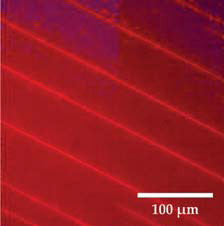Surface-healing nanoparticles find their target
DOI: 10.1063/PT.3.1467
Surface-healing nanoparticles find their target. Taking cues from white blood cells, researchers have become adept at exploiting telltale biochemical markers to selectively deliver drugs to the body parts where they’re most needed. Inspired by that work, theorists led by Anna Balazs (University of Pittsburgh) proposed that similar strategies might be used to repair inanimate materials. Like biological maladies, material damage is often distinguishable by a chemical signature, such as a change in surface energy. Five years ago, Balazs and company described how one might exploit those signatures to deploy reparative nanoparticles to damaged sites. Now, the theorists have collaborated with experimentalists led by Todd Emrick (University of Massachusetts Amherst) to prove the principle in the lab. Emrick’s team prepared an oil-in-water emulsion in which each oily droplet was rich in cadmium selenide nanoparticles and encapsulated by a thin layer of surfactant. While rolling along the oxidized—and thus hydrophilic—surface of a silicone sheet, the microcapsules retain their nanoparticle cargo. But when they encounter a freshly exposed crack—whose surface is unoxidized, and thus hydrophobic—the similarly hydrophobic nanoparticles leak out and coat the crack’s interior. A sufficient number of microcapsules can supply enough nanoparticles to fill the crack and repair the damage. The fluorescent CdSe nanoparticles also serve a diagnostic role: They cause the cracks to appear as bright red streaks in this fluorescence image. (K. Kratz et al., Nat. Nano. 7, 87, 2012. doi:10.1038/nnano.2011.235






